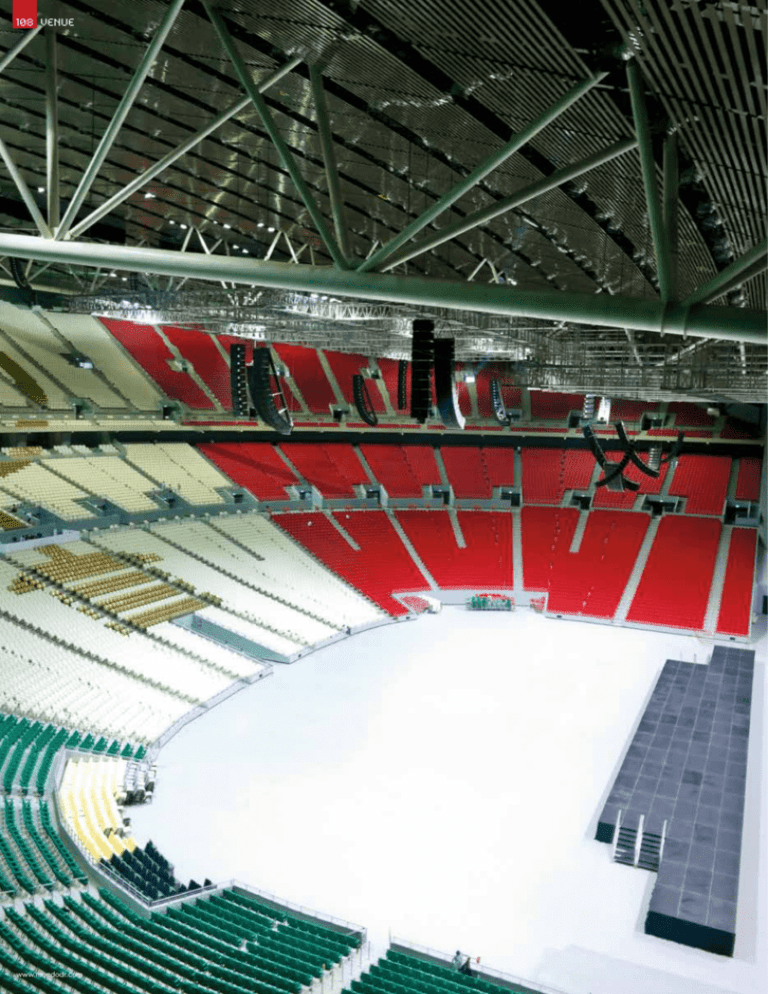Mondo_Sep2014_Philippine_Arena 591 KB - Electro
advertisement

108 VENUE www.mondodr.com VENUE 109 BULACAN PHILIPPINE ARENA VENUES OF THIS ENORMITY ARE SPARSE, SO RACHAEL ROGERSON WAS THRILLED TO HAVE THE OPPORTUNITY TO VISIT THIS PIONEERING INSTALLATION AT THE PHILIPPINE ARENA, AND ONCE THERE SHE WENT TO GREAT LENGTHS TO CAPTURE EVERY ESSENCE OF THE STORY. BULACAN, PHILIPPINES ASIA/PACIFIC/OCEANIA Consider where you’d picture a new, state-of-the-art 75-hectare tourism complex currently under development, in which the first structure to be completed holds eight Guinness World Records. The world records have been received for hosting the world’s largest mixed-use indoor domed arena event with 51,519 attendees and the record for the largest gospel choir made up of 4,745 members. It’s unlikely your guess would be a country that is still considered by some as Third World. Yet the Philippine Arena - a venue with a capacity of up to 55,000, located at the heart of the Ciudad de Victoria development in Bulacan, Philippines - is that megastructure. The Arena is the vision of Bro. Eraño Manalo - the second church leader of Iglesia Ni Cristo (INC), a Christian denominative religion that was founded in the Philippines in 1914 by Bro. Eraño’s father, Bro. Felix Manalo. INC members believe their religion to be the restoration of the original church founded by Jesus. Bro. Eraño took over as executive minister of INC after Bro. Felix’s death in 1963 and after seeing significant growth in the church population he began to envisage a dedicated place for all the members of the church to meet and worship God. Unfortunately, the vision wasn’t realised in his lifetime. Bro. Eraño’s successor, his son, Bro. Eduardo Manalo carried the dream forward and along with the venue’s owner - INC’s educational institution, New Era University - set out plans to erect the Philippine Arena in line with INC’s centennial year. A week after the inauguration of Ciudad de Victoria on 21 July this year, INC celebrated its centennial anniversary at the Philippine Arena. As the host venue, the Arena welcomed almost two million members onsite that day (27 July). The celebrations continued for a full week, with the event being broadcast to approximately 1,180 worship buildings worldwide through live video feed on INC’s own TV channels. Though owned by the church, the Arena will not only be used as a house of worship, it is now open and taking bookings for all different types of events including sports games, music concerts and bespoke events. Church services will occur one or two times a month, while commercial events will take place up to three times per week. Engr. Bessy N. Fetalvero was appointed by INC at the beginning of the project to take charge of contracts, bidding and buildings. Over time her role expanded to include technical specifications meaning she was involved with the selection process for architects, designers, contractors and suppliers. Today, Bessy is the Building Administrator for the entire Ciudad de Victoria site. Bessy said: “The New Era University wanted to build a world-class arena, they wanted it to be recognised globally so all the designs and specifications had to be of a high standard.” This began with New San Jose Builders, the real estate company commissioned to develop the entire Ciudad de Victoria project and Generations Design Asia - headed up by President Gerry Acuzar - the company in charge of project management. It continued with almost every major role for the project being put out to tender, allowing architects, structural engineers, construction and installation teams to bid for the contract. The successful applicants for each section were selected on their previous experience and their company profile. The first to be appointed were Australian architects Populous, structural experts Buro Happold and Korean building constructors, Hanwha E&C. The initial challenge faced by Populous was the sheer capacity of the venue but inspiration came from visualising the relationship between the leader of INC, Bro. Eduardo and his congregation. Populous Senior Principal and Project Director, Andrew James said: “Safety and entering and leaving the building efficiently were the first priorities and then we wanted to create a building where everyone could see and hear one person at the front of the stage as clearly as possible, where there was also a sense of intimacy and a connection, drawing on the atmosphere created when you have 50,000 people in the one space. “We worked to achieve a tight, compact and shallow seating bowl, which is also gracious with its saddle bowl form, high in the centre and dropping down at the flanks. This enables spectators not only www.mondodr.com 110 VENUE confirmed Electro-Voice products were compliant with the design and of course the products fitted the price parameter too.” Although, EVi had not carried out a project of this magnitude before, the company had design and technical support from Electro-Voice’s parent company, Bosch, both the Singaporean and Philippine offices. Prosound from South Africa was brought onboard as a international rigging partner to assist with the design and fabrication of the audio equipment, as well as Tony Sawyer of Electro-Voice Middle East, who was a true support throughout the project particularly during the installation and tuning processes. Bluerig, a local rigging company, also played a major role in the rigging process to support Prosound. The only comparable project for Electro-Voice is the AT&T Arena in Texas, famous home of the Dallas Cowboys NFL team, and to this day it remains the manufacturer’s largest installation. The Philippine Arena is now considered its smaller sibling, being the second largest Electro-Voice installation. This comparison is also replicated in the product series, the AT&T Arena uses Electro-Voice’s X-Line Series to be able to see the speaker on the stage, but also means they are very aware of the other 50,000 people in the arena, helping to create an atmosphere.” Andrew also made sure that the design allowed for easy separation of the lower bowl from the upper tier - which is taken care of by 32 Prolyte Prolyft Aetos chain hoist motors installed on trusses housing curtains supplied and sewn by J&C Joel, with acoustic and thermal properties - should the venue capacity need to be scaled down for a particular event. The realisation of how to make these architectural plans come alive was down to Hong-Kong based Chris Sparrow of Buro Happold - an international engineering consultancy - and his team. They calculated that the Philippine Arena would be built on 99,200 sq metres of land and would have a dome of 36,000 sq metres. The roof would span over 160 metres and be made up of 9,000 tonnes of steel, sitting at a height of 62 metres. Chris also had to ensure that the structure of the Arena was earthquake proof, which he did with the help of research carried out by the Philippine Institute of Volcanology and Seismology. The responsibility of the construction of the Arena lay in the hands of Hanwha E&C, a company based in Korea, which described the undertaking of this US$175m project as a great honour and a chance to show the world its technological capabilities and ability to successfully carry out projects overseas. Hanwha E&C not only constructed the Arena, it was involved from the beginning and was also responsible for the design, working closely with Populous in order to ensure the whole process from design to build ran smoothly and efficiently. It took a total of 30 months for the Arena to be fully complete, and it was only in the two months before the inauguration that the audio element of the project began to take shape. Two rounds of bidding took place for the audio contract. Initially the INC felt it needed an overseas company to equip the Arena with a sound system, mainly due to the fact that no local companies had ever taken on a project of this scale. However, during the second tender application, one local company managed to change that opinion and was awarded the contract in April 2013. The winning bidder was EVI Distribution, distributor of Electro-Voice in the Philippines. EVI General Manager Lito Dungca explained further: “We told INC about Electro-Voice, the brand’s presence in the region, and about the support that we could offer directly from the Philippines. We also gave them some readings from an audio design we put together using EASE modelling software. We had to demonstrate that we could comply with the performance specification outlined by Engineering Harmonics from Canada, and we managed to comply on nearly all of these aspects.” Bessy added further support for the choice: “Electro-Voice had already been specified in other churches and HoW for INC so we were already familiar with the brand, but Electro-Voice did pass through the same procedures as other bidders. The consultant www.mondodr.com large format line arrays, while the Philippine Arena uses the midrange line arrays from the XLCi Series. EVI’s Product Manager, Reynald Rodil, who was heavily involved with the project continued: “The position of where to hang the loudspeakers was determined by Engineering Harmonics. From there, we had to calculate the angles and how many boxes per hang. EASE modelled software did this for us with global support from Bosch.” A total of 18 Electro-Voice XLCi127DVX line array clusters have been installed at the Arena, 12 hangs for the upper bowl and six hangs for the lower bowl, and each hang consisting of 16 cabinets. Lito said: “We could have simply installed 12 boxes per hang, but we opted for 16 to allow for some headroom. When the Arena is full for an event and the people are shouting, you soon realise those extra boxes were needed.” To supplement the lower bowl loudspeaker system, there are a further four line arrays, each comprising 10 Electro-Voice XLCi215 high output subwoofers. While another two Electro-Voice XLD281 three-way compact line arrays - each featuring 14 cabinets - are installed near the retractable seating area for rear fill. All of the hangs mentioned so far are static in their position and none come close to testing the weight load allowance per point. EVI had the option to fly a rig weighing up to 1,800kg per hang, but in reality the line arrays that have been installed are all in the region 112 VENUE of 1,200kg. Prosound from South Africa custom made the mounting brackets for these 20 arrays. Prosound’s Technical Director, Mark Malherbe worked closely on the installation providing guidance and his expert knowledge. After visiting the site, Mark and his team designed the exoskeleton frames - constructed in two sections for ease of handling - for the line arrays to slot into. Due to the slight differences between the flying angles of the array, six variants of the exoskeleton frames were required. Aside from the upper and lower bowl systems, the Philippine Arena is also home to another four line arrays, which are positioned over the floor area. Each line array includes 16 Electro-Voice XLC127DVX cabinets, these are from Electro-Voice’s touring series of products rather than the installation series. “These line arrays can be used as a FOH system, they can be moved and reconfigured depending on the size of the stage. Or if there’s a basketball event for example, the four hangs fire downwards to provide full coverage for the entire floor area,” explained Lito. To complete the cabinet line-up in the Arena are eight Electro-Voice Xsub dual 18-inch subwoofers and 16 Electro-Voice QRx 112/75 two-way loudspeakers for front fill. A total of 232 Electro-Voice TG7 touring amplifiers, which offer 3,500W per channel into two ohm,s provide power for 28 line arrays, the groundstacked subwoofers and the front fill loudspeakers in the Arena. The amplifiers feature an RCM-26 remote control module to enable IRIS-Net compatible DSP and are Dante compliant for audio distribution. Reynald commented: “Everything is networked through IRIS-Net so we can control and monitor the temperature of the amplifiers, we can monitor the health of the amplifiers and loudspeakers, right down to the drivers. It’s a very sophisticated system.” The amplifiers themselves have been installed in the roof, so they are physically close to the line arrays, preventing huge amounts of cabling. Prosound made this part of the installation even smoother by supplying EVI with pre-terminated cables - with the www.mondodr.com pin configuration already in place - therefore it was just a case of plugging the connecting cables into the amplifier racks. Audio networking for the system continues with 44 Electro-Voice Netmax N8000 digital matrix controllers equipped with Dante module cards and analogue and digital I/O cards. The Netmax system works in conjunction with the IRIS-Net protocol to provide flexible routing, DSP, and component-level system control for the Arena, as well as offering the ability to alter the EQ, crossovers, dynamics and loudspeaker optimisation. Reynald explained the audio network further: “The network design was based on advice sought from Audinate, a recommendation from Prosound and what INC wanted, which was a core switch, so we upgraded from a standard network switch to an enterprise switch so it conforms to the ICT infrastructure of the church. INC also wanted to be able to manage the system from its office in Quezon City, managing all its facilities from a single command centre. To do that, all INC venues have to be on the same network infrastructure, meaning we had to comply with those requirements.” Cisco Catalyst 2950 network switches were installed to take care of the Dante network and the IRIS-Net control, while Cisco Catalyst 4500 core switches looks after audio distribution. When it came to tuning the system, the biggest problem EVI faced was slap back, which was present in the Arena, mainly due to the lack of acoustic design. However, after two weeks of time alignment and testing the sound when the Arena was full of people, the slap back became almost unnoticeable. The biggest test of the sound came, of course, with the centennial celebrations. For this, Mark of Prosound was on mixing duty - an experience he described as a privilege to be part of. Mark mixed the event on the in-house console set-up, which includes two Avid Venue Profile mixing systems equipped with 96 channels, one for FOH and one for monitors and an Avid Euphonix System 5-B for broadcast. Aside from the Arena, EVI also installed some Electro-Voice 114 VENUE loudspeakers in the foyer area, known as the entry fill loudspeaker system. In total 56 Electro-Voice Zx1i-100T passive loudspeakers were specified for the periphery of the building, which are powered by three Electro-Voice CPS 8.5 eight-channel amplifiers and one Electro-Voice CPS 4.5 four-channel amplifiers. Similar to the main system racks, these amplifiers are equipped with an RCM-810 module for IRIS-Net control and are Dante enabled. In addition to all the permanently installed technology at the Philippine Arena, there is a healthy line-up of portable audio equipment, which can be brought in and out as and when it’s needed for a particular event. The portable sound system comprises 16 Electro-Voice QRx115/75 full range loudspeakers, four ElectroVoice QRx 218S compact subwoofers and 20 Dynacord CXM 15 stage monitors. Amplification and loudspeaker management for the portable system is provided by nine Electro-Voice CPS 4.10 Class-D amplifiers and once again these are compliant with the IRIS-Net and Dante protocols. There are also four Electro-Voice ELX112P self-powered loudspeakers and a Dynacord Cobra 4 system accompanied by a Dynacord CMS-1600-3 mixing system to complete the portable line-up. The Arena has 18 channels of wireless handheld microphones with Wisycom and DPA microphone heads, and 18 wireless lapel microphones with DPA lapel microphone element. The wireless system can perform a frequency scan of the entire venue to determine which frequencies are still available for use. Additionally, the wireless microphone antenna system provides reliable, stable, www.mondodr.com and wider coverage. Other microphones available at the Arena include Electro-Voice, Neumann, Shure, Earthworks, Sennheiser, and AKG, meaning that any performer at the Arena should have access to their desired choice of microphone. Though audio is the primary technology focus at the Arena, it is worth mentioning its two LED screens - each measuring 22-metres by 12-metres - which provide additional viewing points for the audience. While for lighting, INC has kept permanent equipment to a minimum, preferring to rent equipment in on an event-by-event basis. For the centennial celebrations the entire venue was awash with colour thanks to Lighting Director, John Batalla’s lighting design. He specified more than 200 Clay Paky Sharpy moving heads, 30 Fine Art FINE 2000 Beam fixtures, 80 Fine Art FINE 2000 Wash moving heads, 60 Fine Art FINE 2000 Spot luminaires, 24 Martin Professional Viper intelligent lights and 100 Martin Professional MAC 101 LED lights all controlled via five Avolites Pearl Expert lighting consoles. The fixtures were hung on the Arena’s truss grid system, which was designed, constructed and installed by local company Stage Riggers. COO of Stage Riggers, Joel Inumerable said: “The truss grid system had to be strong enough to carry a substantial amount of loads, however, had to be lightweight at the same time, so not to impose too much dead load on the roof trusses.” More than 1,000-metres of custom-made aluminium truss designed and fabricated using highgrade aluminium alloy using 6061-T6 by Stage Riggers was installed at the Arena. Joel continued: “The roof trusses of the dome were 116 VENUE FRANÇAIS La première structure à être complétée dans un nouveau complexe touristique de pointe de 75 hectares à Bulacan, aux Philippines, est l’Aréna des Philippines, un lieu pouvant accueillir jusqu’à 55 000 personnes, appartenu par la « New Era University », un établissement d’enseignement de l’église Ni Cristo (INC), une religion à dominante chrétienne. Bien qu’appartenant à l’église, l’Aréna ne sera pas uniquement utilisée comme lieu de culte, car elle est maintenant ouverte au public et accepte les réservations pour tous types d’événements. Les propriétaires voulaient construire une arène grandiose qui serait reconnue à l’échelle mondiale ; par conséquent, presque tous les principaux secteurs ont fait l’objet d’un appel d’offres. Les premiers entrepreneurs en bâtiment à être nommés étaient les architectes australiens Populous, les experts en structures Buro Happold et les constructeurs coréens, Hanwha E&C. Deux tours de soumission d’offres ont eu lieu pour le contrat audio et finalement celui-ci fut attribué à EVi Distribution, le distributeur de Electro-Voice aux Philippines. L’arène représente maintenant la deuxième plus grande installation de Electro-Voice au monde. Bien que l’entreprise EVi n’ait pas réalisé de projets de cette ampleur auparavant, celle-ci a été soutenue par des sociétés mères comme Bosch, Prosound d’Afrique du Sud et Tony Sawyer de Electro-Voice au Moyen-Orient. L’entreprise locale, Stage Riggers est également responsable de la conception, de la construction et de l’installation du système de grille en treillis qui comprend plus de 1000 mètres de treillis. designed and constructed by Hanwha E&C and it was designed as a space frame system. Therefore, we designed the truss grid system to be suspended from the joint ball of the space frame, as this was the only point in the entire roof system strong enough to carry the load required.” More than 70 Prolyte Prolyft Aetos chain hoist motors were required to lift the truss grid into position, 32-metres above floor level. Joel said: “Prolyft Aetos motors are very reliable and jam free, we have been using these motors for more than seven years now. We recommended the Prolyft motors to the construction and project managers of the Arena and they approved them.” The Philippine Arena is just the tip of the iceberg for the Ciudad de Victoria complex. The initial design of the development has been likened to the Narra tree - the national tree of the Philippines - with the many different areas of the complex representing the many branches of the Narra tree and the time it will take for the entire project to be complete illustrative of the long growth period required for the Narra tree to mature. Other structures are already underway at Ciudad de Victoria, including the Eraño G. Manalo (EGM) Medical Centre, New Era University, the Philippine Stadium, and the Philippine Sports Centre. There are plans in place for a shopping centre and large scale residential developments. By all accounts, Ciudad de Victoria looks set to become a small city in its own right. TECHNICAL INFORMATION SOUND INSTALLED: 288 x Electro-Voice XLCi127DVX line array element; 64 x Electro-Voice XLCi215 subwoofer; 28 x Electro-Voice XLD281 line array element; 64 x Electro-Voice XLC127DVX line array element; 8 x Electro-Voice Xsub subwoofer; 16 x Electro-Voice QRx 112/75 loudspeaker; 56 Electro-Voice Zx1i100T passive loudspeaker; 232 x Electro-Voice TG7 amplifier; 44 x Electro-Voice Netmax N8000 digital matrix controller; 3 x Electro-Voice CPS 8.5 amplifier; 1 x Electro-Voice CPS 4.5 amplifier; 2 x Avid Venue Profile mixing system; 1 x Avid Euphonix System 5-B broadcast console; Cisco Catalyst 2950 network switches; Cisco Catalyst 4500 core switches; microphones from Electro-Voice, Neumann, Shure, DPA, Earthworks, Sennheiser, AKG PORTABLE: 16 x Electro-Voice QRx115/75 loudspeaker; 4 x Electro-Voice QRx 218S subwoofer; 20 x Dynacord CXM 15 stage monitor; 9 x Electro-Voice CPS 4.10 Class-D amplifier; 4 x Electro-Voice ELX112P self-powered loudspeaker; 1 x Dynacord Cobra 4 loudspeaker system; 1 x Dynacord CMS-1600-3 mixing system TRUSSING & RIGGING 1,000-metres of truss by Stage Riggers; 32 x Prolyte Prolyft Aetos hoist; 20 x Prosound custom-made exoskeleton frame www.facebook.com/pages/The-Philippine-Arena/ www.mondodr.com DEUTSCH Die erste Struktur, die auf einem neuen, hochmodernen, 75 Hektar großen Tourismuskomplex in der philippinischen Provinz Bulacan fertiggestellt wurde, ist die Philippine Arena, einem Treff mit bis zu 55.000 Plätzen, der sich im Besitz der New Era University befindet, einem Bildungsinstitut von Iglesia Ni Cristo (INC), einer christlichen Kirche. Obwohl sich die Arena im Besitz der Kirche befindet, wird sie nicht nur als Gebetsstätte benutzt, sondern ist auch für ganz unterschiedliche Veranstaltungen vorgesehen. Die Besitzer wollten eine WeltklasseArena bauen, die weltweit anerkannt wird. Deswegen wurde beinahe jeder wichtige Bereich des Projekts ausgeschrieben. Die ersten unter Vertrag genommenen Unternehmer waren die australischen Architekten Populous, die Statik-Experten Buro Happold und das koreanische Bauunternehmen Hanwha E&C. Es gab zwei Ausschreibungsrunden für den Audiovertrag, doch letztendlich wurde dieser Vertrag an EVi Distribution, Vertriebshändler von Electro-Voice in den Philippinen, vergeben. Die Arena repräsentiert die weltweit zweitgrößte Installation von Electro-Voice. Obwohl EVi zuvor noch nie an einem solch großen Projekt gearbeitet hat, wurde das Unternehmen durch die Muttergesellschaft Bosch, Prosound aus Südafrika und Tony Sawyer von Electro-Voice Naher Osten unterstützt. Das heimische Unternehmen Stage Riggers war für den Entwurf, den Bau und die Installation des Gitterträgersystems verantwortlich, das mehr als 1.000 Meter Gitterträger umfasst. ITALIANO La prima struttura ad essere completata in un nuovo complesso turistico di eccellenza di 75 ettari, a Bulacan nelle Filippine, è la Philippine Arena, un locale che arriva fino a 55.000 posti, di proprietà della New Era University, un istituto d’istruzione di Iglesia Ni Cristo (INC), una religione denominativa cristiana. Anche se di proprietà della chiesa, l’Arena non sarà usata solo come un luogo di culto, ma ora è aperta ed accetta prenotazioni per tutti i diversi tipi di eventi. I proprietari volevano costruire un’arena che sarebbe stata riconosciuta a livello mondiale, quindi quasi ogni ruolo fondamentale per il progetto è stato messo in gara. I primi appaltatori ad essere nominati sono stati gli architetti australiani Populous, gli esperti strutturali Buro Happold e i costruttori edili coreani Hanwha E&C. Per il contratto audio ci sono volute due battute, ma alla fine il contratto è stato assegnato a EVi Distribution, distributore di ElectroVoice nelle Filippine. L’Arena rappresenta oggi la seconda più grande installazione di Electro-Voice in tutto il mondo. Anche se EVi non aveva mai realizzato prima un progetto di questa portata, la società è stata sostenuta dal partner Bosch, Prosound dal Sud Africa e Tony Sawyer di Electro-Voice Medio Oriente. La società locale, Stage Riggers, si è anche occupata della progettazione, della costruzione e dell’installazione del sistema dell’americana, che comprende più di 1.000 metri di traliccio. ESPAÑOL La primera estructura en ser finalizada en el complejo turístico de 75 hectáreas y de última generación en Bulacan, Filipinas, es el Philippine Arena, un lugar con capacidad de hasta 55.000 personas, propiedad de la Universidad Nueva Era, un instituto educacional de la Iglesia en Cristo (INC), de denominación Cristiana. A pesar de pertenecer a una iglesia, el Estadio no solo será utilizado como casa de adoración, sino que actualmente se encuentra tomando reservas para todo tipo de eventos diferentes. Los dueños quisieron construir un estadio de primer nivel que fuera reconocido mundialmente. Por lo tanto, casi todos los roles principales del proyecto fueron llamados a licitación. Los primeros contratistas en ser convocados fueron los arquitectos australianos Populous, los expertos en estructuras Buro Happold y los constructores Coreanos, Hanwha E&C. Para el contrato de la parte del audio se realizaron dos rondas de licitaciones pero finalmente el contrato fue otorgado a EVi Distribution, distribuidor de Electro-Voice en las Filipinas. El Arena representa actualmente la segunda instalación más grande de Electro-Voice del mundo. A pesar de que EVi no había llevado a cabo un proyecto de esta envergadura anteriormente, la empresa tuvo el soporte de Bosch, Prosound de Sudáfrica y Tony Sawyer de Electro-Voice Medio Oriente. La empresa local, Stage Riggers también fue responsable de diseñar, construir e instalar el sistema de estructuras metálicas colgantes compuesto por más de 1.000 metros de abrazaderas.






